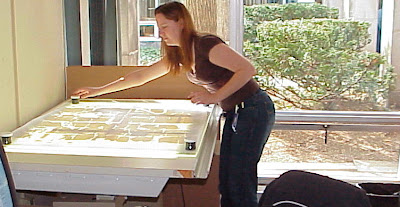View Pennsylvania State Archives in a larger map
Visit our Tour Destination:
 |
| Project Conservator Lindsay Bergen pieces together the Muster Out Roll of Co. K of the 71st Regiment. Photo courtesy of the Pennsylvania State Archives. |
Website: Pennsylvania Historical & Museum Commission: Civil War Records at the Pennsylvania State Archives
The Treasure: A
wealth of important historical information is preserved on the Pennsylvania Civil
War Muster Out Rolls, which record key details on approximately 362,000
soldiers from the Commonwealth
of Pennsylvania
Accessibility: Information
on how to research the Civil War documents at the Pennsylvania State Archives
is available at the web page Civil War Records at the Pennsylvania State Archives. The Civil War Muster Rolls are being scanned by Ancestry.com and are
anticipated to be accessible online by late summer 2013.
 |
| Archivist Rich Saylor in the archives tower stack area with the 135 cartons of Muster Out Rolls before treatment. Photo courtesy of the Pennsylvania State Archives. |
Background: As
the Civil War came to a close in 1865, the Pennsylvania Adjutant General’s Office
confronted a flood of paper from the field. The Adjutant General’s Office had
responsibility for much of the paperwork of war, covering Muster In Rolls
(documenting the entry of soldiers into service), Alphabetical Rolls, Lists of
Deserters, and Muster Out Rolls (documenting the status of soldiers at the
completion of their service). These were the state’s databases, prepared and
organized by hand. Many of the Muster Out Rolls date from the war’s end, as
companies moved through the business of disbanding.
Ultimately, the Pennsylvania Adjutant General’s Office
collected over 2,500 muster-out rolls, recording the exit status of
approximately 362,000 soldiers. Only New York
State contributed more Union soldiers
to the war effort than Pennsylvania .
A number of Pennsylvanians became prominent leaders in the cause. Noted generals from Pennsylvania
include George Meade, George B. McClellan, Winfred Scott Hancock, John Fulton
Reynolds, John F. Hartranft, and John W. Geary. But the Muster Out Rolls are
egalitarian—they studiously document the status of the legendary Civil War
heroes alongside the common soldiers and even the deserters.
 |
| A typical muster roll, before treatment: Note the damage on the folds that were mended with pressure-sensitive tapes. Photo courtesy of the Pennsylvania State Archives. |
As the companies disbanded, the field clerks gathered the
information, including the status of company members who were missing or dead.
The Adjutant General’s Office provided the oversize forms—unfolding to more
than three feet in width and two feet in height. Under the pre-printed
masthead, the officers and clerks would fill in the information on the ruled
lines. The status of dozens of soldiers could be recorded on each document.
Notes provide tantalizing information, now deeply valued by today’s historians
and genealogists: “prisoner at
Andersonville,” “wounded at Chancellorsville,” “recovering in hospital,”
“deserted,” “lost,” or “died at Antietam .”
For the first half-century of their existence, the Muster
Out Rolls were valued primarily for very practical reasons, such as verifying
pensions and veteran’s claims. Subsequently, historians and genealogists
continued the high level of demand. Time after time, the documents were unfolded
then refolded, becoming blemished with dirt and grime. Losses started to occur
along the weakening folds. Well-meaning office workers applied highly acidic
pressure-sensitive tapes to hold the sheets together. Historians and genealogists loved the
accurate and color detail in the documents, but the paper itself was literally falling
apart.
Notes from the
Editor: With funding from Save America’s Treasures and the
Pennsylvania General Assembly, the Pennsylvania Muster Out Rolls have received
state-of-the-art treatment and rehousing. More than 1,000 of the documents—the
ones judged to be in the worst condition—came for treatment to the Conservation Center
The treatment required surface cleaning, washing, mending,
flattening, lining, and encapsulating. All the old acidic mending tapes had to
be removed, sometimes loosening fragments of paper that had to be refitted
into the document like in a jigsaw puzzle. In 2009, CCAHA Book Technician
Valeria Kremser (now Book Conservation Technician at the University of Pennsylvania
 |
| Above: Before treatment image of a folded Muster Roll. Below: After treatment image of the same Muster Roll, now unfolded. Photo courtesy of the Pennsylvania State Archives. |
Other Recommended
Sites: In the Pennsylvania State Capitol complex in Harrisburg , you can visit the Pennsylvania State Archives
and the neighboring State Museum of Pennsylvania ,
and then take a guided tour of the historic State Capitol Building itself.
 |
| The Pennsylvania State Archives. Photo courtesy of the Pennsylvania State Archives. |
Tour America's History Itinerary
Tuesday: Gettysburg National Military Park
© 2013 Lee Price










